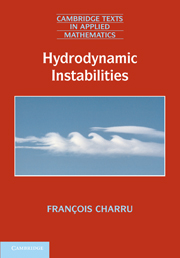Book contents
- Frontmatter
- Contents
- Foreword
- Preface
- Video resources
- 1 Introduction
- 2 Instabilities of fluids at rest
- 3 Stability of open flows: basic ideas
- 4 Inviscid instability of parallel flows
- 5 Viscous instability of parallel flows
- 6 Instabilities at low Reynolds number
- 7 Avalanches, ripples, and dunes
- 8 Nonlinear dynamics of systems with few degrees of freedom
- 9 Nonlinear dispersive waves
- 10 Nonlinear dynamics of dissipative systems
- 11 Dynamical systems and bifurcations
- Appendix A The Saint-Venant equations
- References
- Index
Appendix A - The Saint-Venant equations
Published online by Cambridge University Press: 05 August 2011
- Frontmatter
- Contents
- Foreword
- Preface
- Video resources
- 1 Introduction
- 2 Instabilities of fluids at rest
- 3 Stability of open flows: basic ideas
- 4 Inviscid instability of parallel flows
- 5 Viscous instability of parallel flows
- 6 Instabilities at low Reynolds number
- 7 Avalanches, ripples, and dunes
- 8 Nonlinear dynamics of systems with few degrees of freedom
- 9 Nonlinear dispersive waves
- 10 Nonlinear dynamics of dissipative systems
- 11 Dynamical systems and bifurcations
- Appendix A The Saint-Venant equations
- References
- Index
Summary
In this appendix we shall derive a system of depth-averaged conservation equations, the classic Saint-Venant equations (de Saint-Venant, 1871), which give a good description of the dynamics of a fluid flow when the spatial scale λ of the variations in the longitudinal direction x is large compared to the flow depth or thickness, h. These equations do not explicitly involve the nature of the flowing medium, and so they are valid, under certain conditions stated explicitly below, for a fluid flow either laminar or turbulent, as well as for a granular flow. The equations can be obtained by two equivalent methods: by depth-averaging the local conservation equations in the transverse direction, or by writing down the conservation laws for a control volume corresponding to a slice of fluid of thickness dx. Here we shall use the latter method.
Outflow from a slice of fluid
Let us consider a flow in the x-direction, inclined at an angle θ relative to the horizontal, between a bed located at y = yb(x, t), where y is the transverse direction, and a free surface at y = (yb + h)(x, t), where h is the local flow depth (Figure A.1).
We define the control volume as the slice of fluid between the two planes at x and x + dx. At any point on the boundary of the control volume, let n be the exterior normal, u the fluid velocity and w the speed of the boundary.
- Type
- Chapter
- Information
- Hydrodynamic Instabilities , pp. 369 - 374Publisher: Cambridge University PressPrint publication year: 2011



